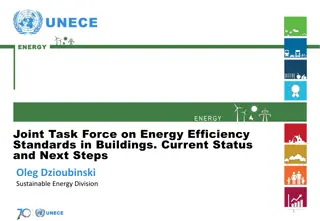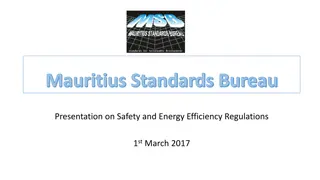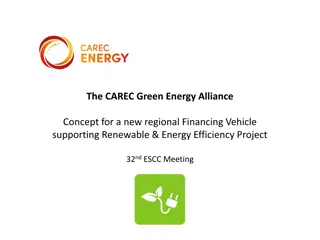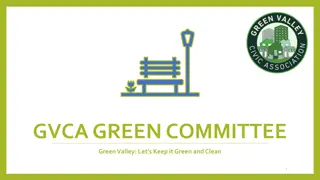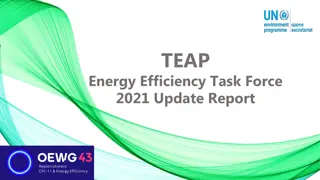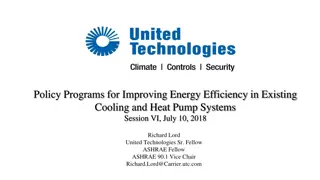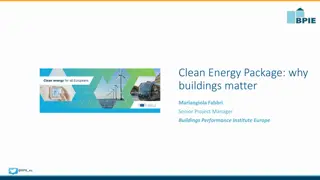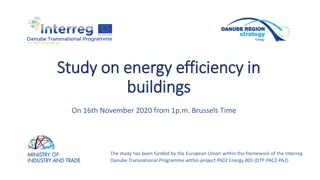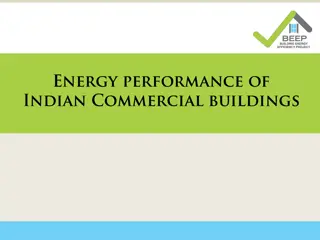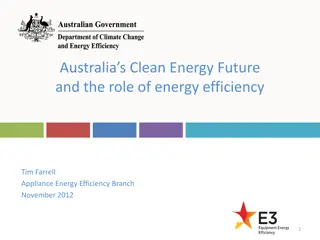Enhancing Energy Efficiency in Commercial Buildings Through Green Standards
This update highlights the role of standards and conformity assessment measures in improving the performance and energy efficiency of commercial buildings. Through workshops, sharing experiences, and studies on building codes and regulations, efforts are made to encourage consistent green building standards and practices. The objective is to foster transparency and innovation while avoiding trade barriers, ultimately promoting a cleaner and more energy-efficient commercial building sector. With a focus on collaboration between APEC and ASEAN economies, various initiatives aim to enhance building performance through green building codes and information modeling standards.
- Energy Efficiency
- Green Building Standards
- Commercial Buildings
- Standards and Conformity
- Building Performance
Download Presentation

Please find below an Image/Link to download the presentation.
The content on the website is provided AS IS for your information and personal use only. It may not be sold, licensed, or shared on other websites without obtaining consent from the author. Download presentation by click this link. If you encounter any issues during the download, it is possible that the publisher has removed the file from their server.
E N D
Presentation Transcript
Update from the United States Energy Related Work in the Sub Committee on Standards and Conformance April 2014
M CTI 02/12 A Role of Standards and Conformity Assessment Measures in Enhancing the Performance and Energy Efficiency of the Commercial Building Sector U.S.-led APEC green building Multi-Year Project runs 2013-2015 Builds on work begun in 2011 EGEE&C is partner APEC fora Cooperation with ASEAN ACCSQ
Objectives Encourage consistent, transparent, and appropriate green building standards-related measures, thus avoiding the creation of unnecessary obstacles to trade. The Identify best practices in standards and code development, and testing and rating of building products that support a cleaner, more energy efficient commercial building sector.
Workshop 1: Sharing Experiences in the Design and Implementation of Green Building Codes March 2013 Lima, Peru A joint APEC ASEAN workshop , developed and implemented in collaborative partnership with Peru Informed by: Peru survey - Sharing Experiences in the Design and Implementation of Green Building Codes in the APEC Economies U.S. study Building Codes and Green Codes in the APEC Economies Sharing of information, experiences, and best practices among APEC and ASEAN economies
Study: Building Codes, Regulations, and Standards Objective: Understand how economies utilize building codes to increase building performance. For each of the 21 APEC economies, the study provides in-depth information about: Approach to building regulation Development, adoption, administration, enforcement Roles of government and private sector Existing building codes Minimums for key elements Referenced standards Green elements of existing codes Stand-alone green codes Protocols for monitoring, review, and assessment Available at: http://publications.apec.org/publication-detail.php?pub_id=1442
Workshop 2 How Building Information Modeling (BIM) Standards Can Improve Building Performance June 2013, Indonesia Joint APEC-ASEAN event Diverse presentations by member economies and expert BIM professionals to highlight: Current status of BIM standards development Benefits of BIM to policymakers, architects and designers, construction industry actors, building owners, and others Case study success stories showing the practical implementation of BIM projects Concrete steps that can be taken by economies to increase BIM usage toward improving building performance
Start-Up Guide Building Information Modeling Provides economies with specific actions to take to advance BIM uptake, with associated benefits. The Start-Up Guide details Actions and Benefits associated with: Defining metrics aligned with an economy s priorities Planning BIM policies BIM policy adoption Technology to provide the right BIM tools Published on APEC web site http://publications.apec.org/publication- detail.php?pub_id=1510
Green BuildingsWork in 2014 Work reoriented to continue emphasis on green codes and BIM Ongoing ACCSQ engagement Desire stronger linkage with EGEE&C 2014 Events BIM Workshop Beijing/ SOM 3 in August New Orleans in October Green Codes Workshop
Plans for 2014 Other Projects CTI 27 2013 A Aligning Energy Efficiency Regulations for ICT Products Implementing A Strategic Approach First project under the newly formed ICT Global Energy Efficiency Convergence Forum Workshop and Inaugural Meeting of ICT GEEC Forum at SOM III in Beijing, China - August 2014 Day 1 Government and business discussion on aligning EE regulations Day 2 APEC Member regulators meet at ICT GEEC Forum Progress Completed Economy survey on utilization of IEC62623 for EE testing of personal computers Preparing for implement of pilot projects to examine applicability of IEC E3 program for transportability of EE test data Welcome collaboration with the EGEE&C
Plans for 2014 Other Projects APEC Regulatory Cooperation Advancement Mechanism (ARCAM) - Dialogue on Electric Vehicle (EV) Standards Will build on discussions and recommendations from the 2011 ARCAM Smart Grid Interoperability Standards Dialogue May 7, 2014, Qingdao, China Session 1 Overview of APEC Economies EV Regulations Session 2 Challenges of Convergence in International Standards for EVs Session 3 EV Technical Areas of Harmonization and Alignment Session 4 Overview of Efforts in International Fora to Harmonize EV Standards Session 5 What can APEC do to align EV regulations and promote harmonization of EV international standards?
For more information: Green Buildings (M CTI 02 12A) Renee.Hancher@trade.gov ICT (CTI 27 2013 A) Michael.Boyles@trade.gov ARCAM Edward_Brzytwa@ustr.eop.gov






